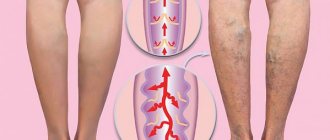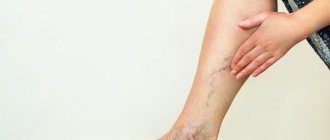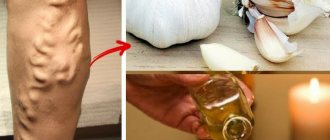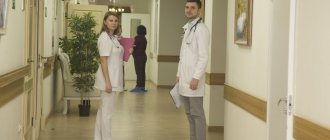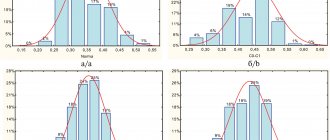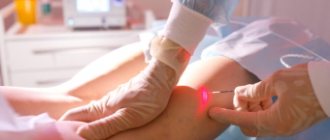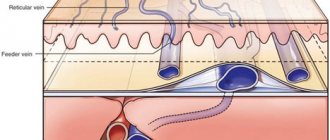Varicose veins of the lower extremities. Causes of the disease (Wikipedia and the official approach):
There are primary and secondary varicose veins of the lower extremities. Secondary develops as a result of injuries, tumors, etc., when the venous system cannot fully perform its functions.
Occupations in which varicose veins most often develop
Primary develops due to weakness of the venous wall. Reasons that contribute to the development of varicose veins of the lower extremities:
- pregnancy;
- hormonal imbalance;
- heavy static loads;
- smoking;
- work that requires standing for long periods of time (for example, hairdressers, salespeople, waiters);
- sitting in an incorrect position, especially crossing your legs;
- high-heeled shoes;
- sedentary lifestyle.
All these factors contribute to a deterioration in the outflow of blood from the lower extremities, thereby the superficial veins become overfilled, dilate, and blood stagnation occurs. Heredity plays an important role in the development of the disease.
Other causes of varicose veins
Such a wide prevalence of varicose veins in highly developed countries is certainly associated, among other things, with the lifestyle of the population. For example, we spend a lot of time sitting on chairs. From kindergarten until graduation, a person sits for at least 40 hours a week (counting approximately 5 hours during the day in class, 3 hours in the evening doing homework, watching TV, and so on - 5 days a week). Now let's multiply these hours by 10 months a year, and so on - up to 17 years. Then - work in some institution where you have to sit even longer. When a person sits in a chair, the veins running along the back of the thighs are compressed, and the calf muscles (the rhythmic contractions of which help move venous blood to the heart) do not work.
Another important factor is nutrition. In Western countries, people prefer a low fiber diet. With such a diet, there is a high tendency to constipation. Which also has an extremely negative impact on the condition of the venous valves and contributes to varicose veins.
Varicose veins of the lower extremities - symptoms
Varicose veins of the lower extremities are accompanied by the following symptoms:
- swelling of the legs at the end of the working day;
- feeling of heaviness in the legs;
- cramps in the calf muscles, mainly at night;
- pain, burning sensation in the legs;
- spider veins on the legs;
- formation of trophic ulcers.
Spider veins are small red-blue nodules on the skin that can be seen on the legs at the very beginning of the disease. Often, varicose veins of the lower extremities during pregnancy cause particular discomfort.
What is telangiectasia or spider veins?
Telangiectasia is a vascular formation, which is a persistent dilatation of skin vessels of small diameter (arterioles, venules, capillaries) of a non-inflammatory nature, morphologically manifested by spider veins or meshwork. The diameter of dilated vessels is 0.5-1.5 mm.
This is what spider veins on the legs look like
Varicose veins of the lower extremities - stages
There are several stages of disease development:
- compensation – spider veins and tortuous veins appear on the legs, no complaints
- subcompensation – there are complaints of swelling, cramps of the calf muscles, a feeling of heaviness, fatigue in the legs, pronounced dilated veins are visually determined
- decompensation – dermatitis, minor hemorrhages are added, the skin becomes dense, dry, easily wounded, pigment spots appear
The earlier the disease is detected, the easier it is to treat.
What is a reticular (varicose) vein?
Reticular (intermediate) veins are venous vessels of medium caliber (diameter from 1.5 to 4 mm), they are larger than venules and capillaries, but smaller than the main saphenous veins. Quite often these veins become varicose and develop valvular insufficiency. This condition is called reticular varicose veins.
Reticular varicose veins
It can be either an independent disease or combined with varicose veins of the main saphenous veins. In almost 100% of cases, reticular varicose veins will be accompanied by multiple telangiectasias. Moreover, the latter often occur without the presence of reticular varicose veins. Both of these pathological conditions are combined into class C1 of the international classification CEAP and, as a rule, have close pathogenetic connections.
Varicose veins of the lower extremities - diagnosis
To accurately diagnose the disease, you must consult a doctor. Vascular surgery deals with varicose veins of the lower extremities. To make a diagnosis, in addition to complaints and visual examination, it is necessary to use special research methods.
Ultrasound diagnosis of varicose veins of the lower extremities
Duplex angioscanning is considered the gold standard. This method combines ultrasound and Doppler scanning. Thus, it is possible to see the condition of the vascular wall in real time and assess the speed of blood flow in the venous system of the lower extremities.
Varicose veins of the lower extremities - complications
If there are varicose veins of the lower extremities, treatment should begin faster, otherwise the disease will progress, which is fraught with serious complications. Stagnation of blood in the veins contributes to the formation of blood clots, phlebothrombosis develops, and if the vein also becomes inflamed, thrombophlebitis develops.
Acute thrombophlebitis of superficial veins
The resulting blood clots can break free from their place at any time and enter the bloodstream. In this case, the blood clot enters the veins of the lungs, blocking them. In this case, a person can die from suffocation even before the ambulance arrives, because such a formidable complication is extremely difficult to treat even in a specialized hospital, and there is very little time to save a life.
In addition, due to blood stagnation, nutrition of the lower extremities is disrupted. Deep trophic ulcers form on the skin, which heal poorly and tend to spread. This can lead to amputation of the limb.
Based on the fact that complications of varicose veins of the lower extremities are not at all harmless, it is necessary to contact a qualified specialist as soon as possible. Only a doctor can prescribe effective treatment and help avoid complications.
C5 and C6 stages
C5 and C6 – stages of varicose veins with ulcerative lesions of the skin and subcutaneous tissue of the leg. C6 – open ulcer, C5 – healed ulcer. The appearance of a skin defect on the leg is very difficult and painful for the patient. In addition, a person has to constantly treat the skin so that suppuration does not occur, and the ulcerative defect itself is usually very painful. It is difficult for a person to wear clothes or shoes; every touch causes pain. If a person is young enough, the appearance of an ulcer on the leg greatly reduces social adaptation (he cannot go to the pool, bathhouse, or beach, and is forced to hide his illness).
An ulcerative defect reduces immunity, being an entrance gate for infection, it draws protective blood cells to fight bacteria that constantly penetrate the wound. A person is forced (wasted) to spend a lot of money on ointments, tablets, dressings, consultations with doctors in order to fight his ulcer, not suspecting that most ulcers can be successfully treated with modern methods! The problem is that no LOCAL treatment with ointments and creams can cure an ulcer if the cause of the disease is not eliminated. In the case of a venous ulcer, this cause is VARICOSIS. Without eliminating the problematic vein, through which venous blood constantly flows into the ulcer (WITH WASTE!!!), causing swelling of the ulcer surface and a huge concentration of waste harmful substances in the wound, the ulcerative defect will not heal! In addition, cases of malignancy of long-existing ulcerative defects (degeneration into ulcerative skin cancer) have been described.
Please note that the causes of trophic ulcers on the skin are a large number of diseases, such as severe atherosclerosis of the arteries of the legs, fungal or bacterial infections of the legs, high blood pressure (Martorell's ulcer), lymphostasis, previous erysipelas, obliterating endarteritis, deep vein thrombosis and postthrombophlebitis illness, as well as a number of others. The treatment of these diseases is very different, and in some cases directly opposite, to the treatment of venous trophic ulcers, and it is not recommended to treat the ulcerative defect on your own, without the supervision of a doctor, because for the above diseases, recommendations effective for the treatment of venous ulcers can greatly aggravate the condition of the ulcer caused by non-venous pathology!
Venous ulcer C6
Currently, the treatment of ulcerative venous defects is very effective using modern compression materials, the latest generation of dressings, as well as the most gentle method for eliminating varicose veins - endovenous laser obliteration.
Varicose veins of the lower extremities - how to treat with ointments
In the pharmacy you can find a huge number of ointments for varicose veins of the lower extremities. They are based on substances that improve tissue trophism, relieve swelling and strengthen the vascular wall. Varicose veins of the lower extremities, photos and reviews of ointments are available on the drug pages on the Internet.
Treatment of varicose veins with ointments and gels
In the early stages of the development of the disease, the use of various ointments can improve the condition of the venous system and slow down the progression of the disease, but it will not be possible to completely defeat varicose veins of the lower extremities. The results will be available only after visiting a doctor.
Compression garments for varicose veins
In the early stages and after treatment, men are recommended to wear compression garments, which are selected individually. Anti-varicose underwear is similar in appearance to classic underwear, but there are no seams. The fabric consists of nylon, microfiber and lycra. The fabric is breathable and pleasant to the touch.
Compression jersey for men is divided into:
- stockings for varicose veins of the thighs,
- tights if both legs are affected,
- knee socks if the disease is on the calves or just above the knee.
You need to purchase underwear at the first sign of the disease.
Tips for wearing compression stockings:
- Put on your underwear carefully so as not to tear the product.
- File your fingernails and toenails to avoid tearing your underwear.
- Put it on in the morning, without waiting for swelling.
- Remove compression garments before going to bed.
- If it is difficult for an overweight patient to put on compression garments on their own, it is recommended to purchase a device for putting them on.
- Wash clothes in warm water with baby soap. To prevent water from getting on the silicone, tighten the upper part with thread, and clean the elastic band with a cotton pad in alcohol.
Device for putting on compression garments.
Varicose veins of the lower extremities - treatment: surgery or still a procedure?
- Intravascular coagulation. Do you have varicose veins of the lower extremities? Laser treatment in Moscow is a small endovascular operation during which a vein is obliterated with a laser. Varicose veins of the lower extremities will be removed; laser treatment is based on the introduction of blood flow into the desired vein. This is how varicose veins of the lower extremities are defeated. Laser treatment, the cost of which is not so high, takes little time and is well tolerated by patients, and they forget that they had varicose veins of the lower extremities; laser treatment (the price in our center is affordable) is very effective. The final figure depends on the stage of the disease and the amount of work the doctor does. Do not be afraid that varicose veins of the lower extremities will attack again later. Laser treatment (there are quite a lot of reviews!) will definitely put you “on your feet”!
- Short stripping is a minimally invasive technique in which a small section of the affected main vein is removed. In this way, it is possible to preserve as many healthy sections of veins as possible.
- Cryophlebectomy – removal of a vein using a cryoprobe. The operation is low-traumatic - however, one small incision is made to insert the probe. After the operation, you see results immediately.
Diagnostics
Diagnosis of varicose veins, determination of the nature and severity of hemodynamic disorders in the veins of the legs is the prerogative of a phlebologist.
Diagnosis of initial varicose veins includes (9, English):
- clinical examination with functional tests;
- Ultrasound Doppler Doppler (USD) of the vessels of the lower extremities to assess the nature of blood flow and identify valvular insufficiency in superficial veins and perforators;
- if necessary, consultations with other specialists (gynecologist, endocrinologist, gastroenterologist) and tests to determine the main causative factor in the development of venous hypertension.
Invasive diagnostic techniques are currently practically not used, since the information obtained with their help does not have much clinical significance. An ultrasound scan is usually sufficient.
Varicose veins of the lower extremities - treatment with radiofrequency
How to remove varicose veins of the lower extremities? RFA treatment is of particular interest to patients. Why do many people dream of eliminating varicose veins of the lower extremities and prefer RFO treatment?
Radiofrequency ablation (RFA) is an operation that can be performed on an outpatient basis if you want to forget varicose veins of the lower extremities. RFA treatment in Moscow uses radio frequency, which is used to “seal” a vein and remove varicose veins of the lower extremities. RFO treatment in Moscow is fast and effective.
Classification by shape
The most pathogenetically substantiated is the classification proposed in 2000 in Moscow at a meeting of leading domestic specialists in the field of venous pathology. The modern Russian classification reflects the degree of chronic venous insufficiency, the form of varicose veins and complications caused by varicose veins.
Forms of varicose veins:
- I. Segmental damage to subcutaneous and intradermal vessels without reflux.
- II. Segmental varicose veins with reflux along the superficial and/or communicating veins;
- III. Widespread varicose veins with reflux along the superficial and communicating veins;
- IV. Varicose veins in the presence of reflux in the deep veins
Degree of chronic venous insufficiency
- 0 - absent
- I - “heavy legs” syndrome, turning into edema
- II - persistent edema, hyper- or hypopigmentation, lipodermatosclerosis, eczema
- III - venous trophic ulcer (open or healed)
Complications:
complications during the clinical course: thrombophlebitis, lymphangitis, lymphadenitis, bleeding from varicose veins, eczema, frequent erysipelas, trophic ulcers. Although the cause of death may be bleeding from a trophic ulcer, more often patients die from secondary venous thromboembolism of the branches of the pulmonary artery. Venous stasis and trauma from varicose veins often cause superficial thrombophlebitis, which can spread through perforating veins to the deep venous system. This circumstance should always be kept in mind when treating patients with varicose veins, since the mortality rate for unrecognized and untreated pulmonary embolism (PE) ranges from 30 to 60%.
Caution - varicose veins of the lower extremities
Treatment with traditional methods (prices for herbs and creams differ), but still do not place too much hope on a green pharmacy.
Excess weight provokes the development of varicose veins
It is important to pay attention to nutrition if you have varicose veins of the lower extremities, treatment with traditional methods, the price of which is pennies. It is necessary to limit the consumption of meat, spicy, salty and smoked foods, increase the amount of vegetables and fruits in the diet and eliminate alcohol and coffee.
An optimal daily routine and therapeutic exercises will help improve blood circulation in the extremities. This will take 10-15 minutes a day.
Simple traditional methods of treatment can complement the complex of measures for the treatment of varicose veins. Rubbing the feet with horse chestnut tincture, apple cider vinegar, butter with garlic and many other remedies have been known since ancient times. They will ease varicose veins of the lower extremities, the cost, photos and results can be viewed on our website on the Internet.
Sclerotherapy (removal of asterisks) - price of the procedure
One of the advantages of our phlebology center in Moscow is the prices for sclerotherapy; they are quite affordable and accessible to any category of patients.
| Service provided | Cost (price) of the service |
|
|
|
|
|
|
Varicose veins of the lower extremities - prevention
For prevention, it is necessary first of all to adhere to the work regime. You cannot constantly be on your feet or sit in one position. From time to time it is worth taking short breaks to give your legs a rest.
After a hard day at work, you can massage your feet, after which it is advisable to put your feet on a raised platform. This improves blood flow from the extremities.
Exercises to improve venous blood flow in the legs
Don't get carried away with hot baths and saunas. To prevent varicose veins, it is much more useful to take a contrast shower and rinse your legs with cool water.
It is important to monitor your weight. Excess body weight increases the load on the venous system and contributes to the development of the disease.
If there is a predisposition to developing the disease, and it is not possible to eliminate all risk factors, it is better to engage in prevention. Even if the disease has already begun, do not despair. Varicose veins of the lower extremities are not a death sentence. By detecting the problem in a timely manner and contacting specialists, you can get rid of the disease and avoid serious complications.
We invite you to visit our specialist phlebologist and get rid of varicose veins in the early stages.
Treatment
The treatment methods used for varicose veins are divided into conservative and surgical. Typically, a treatment regimen includes both of these components.
For the treatment of varicose veins at the initial stage, drugs of various groups are widely used, with preference given to phlebotonics in tablet form and as part of ointments. Their regular use in most cases makes it possible to compensate for incipient venous insufficiency, which has a beneficial effect on the patient’s condition (English). Some medicinal plants have approximately the same effect, which explains the frequent use of herbal medicine - both in the form of decoctions and infusions for oral administration, and in the form of herbal preparations.
In addition to drug treatment, the following may be used:
- physiotherapy;
- compression jersey;
- exercise therapy;
- diet therapy - normalizing body weight will reduce the load on the vessels of the lower extremities.
All conservative methods have only a restraining and compensating effect. No drug is capable of restoring sclerotic and deformed veins and the valves located in them.
At the initial stage, an excellent effect can be obtained with sclerotherapy; varicose veins of large diameter are eliminated with a laser - both treatment technologies will relieve not only the unsightly looking vessel, but also the existing venous insufficiency. Healthy deep veins take over the drainage of venous blood. After a short period of adaptation, the blood flow system is completely compensated, phlebostasis is stopped, microcirculation is normalized.
Frequently asked questions from our patients on the Internet about varicose veins of the lower extremities
Are varicose veins of the lower extremities dangerous during pregnancy? Anastasia from Belgorod is interested in:
Dear Anastasia! Varicose veins of the lower extremities during pregnancy carry certain risks of developing thromboembolic complications. Therefore, it is necessary to contact a phlebologist and follow his recommendations.
I have had varicose veins of the lower extremities for quite a long time, what surgery is best? Tamara from Ufa asks:
Dear Tamara! If you have varicose veins of the lower extremities, modern minimally invasive surgery will be optimal. The best methods today are thermoobliteration techniques (laser and radio frequency).
I was diagnosed with varicose veins of the lower extremities, how is the operation performed? Boris from St. Petersburg is interested in:
Dear Boris! You have been diagnosed with varicose veins of the lower extremities, and therefore surgery is indicated. In Russia there is no uniform approach to the choice of surgical treatment. There is a classic and outdated phlebectomy technique, with incisions and anesthesia. This operation is usually performed in public hospitals. In specialized phlebological centers, innovative techniques are used through puncture approaches (punctures). Such operations are performed on an outpatient basis, under local anesthesia, without incisions or pain.
Varicose veins of the lower extremities, what is it? Elena from Pskov is interested in:
Dear Elena! Varicose veins of the lower extremities are a chronic progressive disease, manifested by pathological dilation of venous vessels, disruption of the normal functioning of vein valves, which adversely affects blood flow. This condition often develops in people whose work and lifestyle are associated with prolonged static load.
Varicose veins of the lower extremities, what treatment is used? Natalya from Petrozavodsk is interested in:
Dear Natalia! When a diagnosis is made: varicose veins of the lower extremities, a fairly varied treatment is used. The conservative approach has many supporters, both among patients and doctors. But we must immediately clarify that treatment of varicose veins of the lower extremities cannot only be conservative. Modern treatment of varicose veins involves the use of innovative techniques that radically eliminate the pathology. You can see reviews from patients of our clinic on our website:
Prevention
In order not to feel what varicose veins are, we recommend following simple rules:
- alternate work and rest;
- limit physical activity and standing work;
- exclude visiting saunas and baths;
- switch to a healthy lifestyle;
- promptly contact a phlebologist when you notice the first symptoms of varicose veins;
- exercise therapy.
Read more in the article How to strengthen the walls of blood vessels. Prevention of varicose veins.

